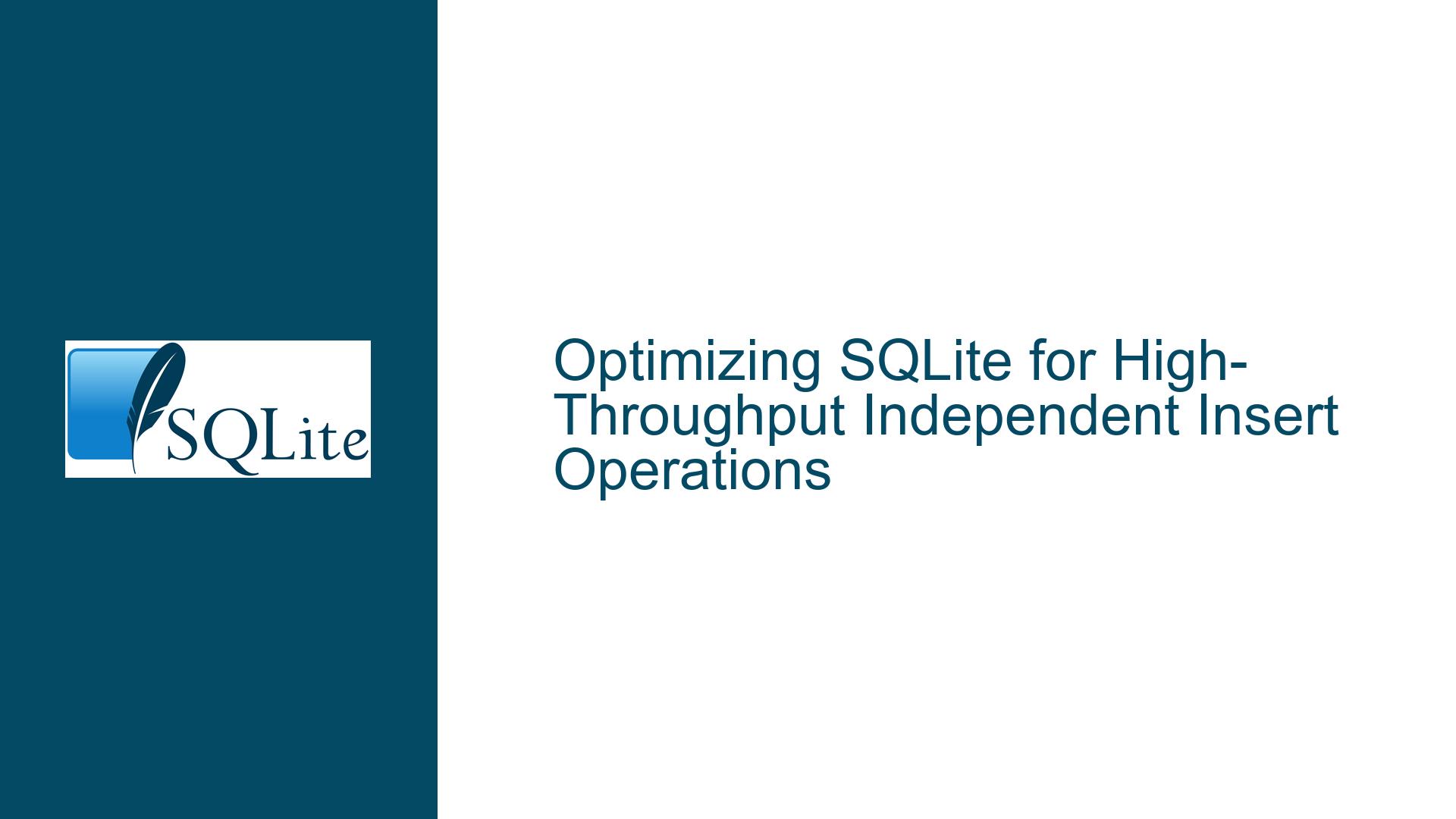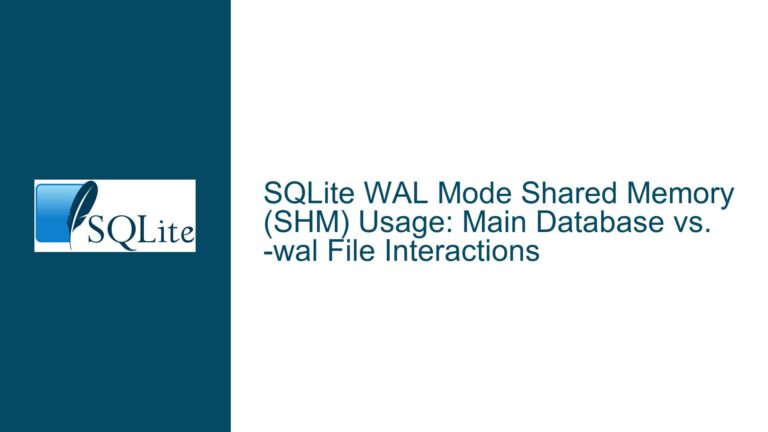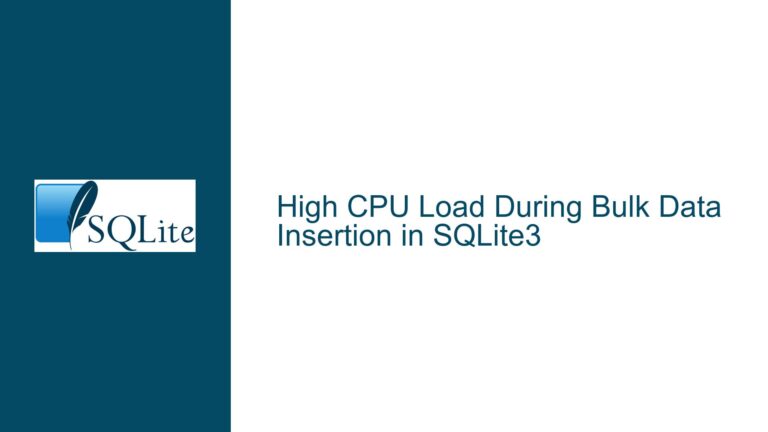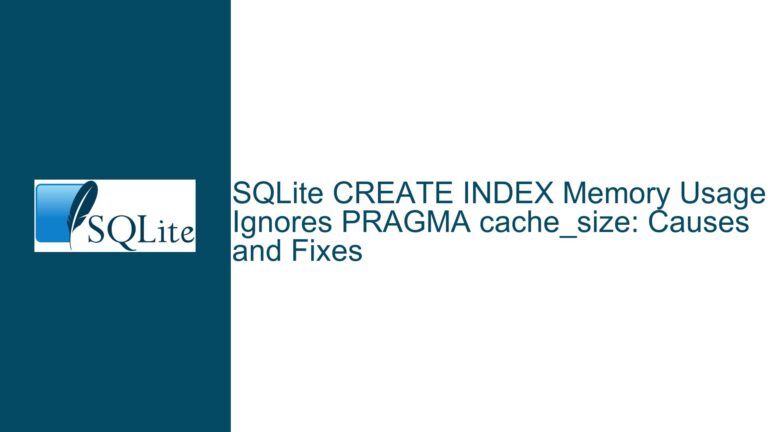Optimizing SQLite for High-Throughput Independent Insert Operations
Understanding Performance Bottlenecks in Concurrent SQLite Insert Workloads
The challenge of achieving high insert throughput in SQLite under concurrent workloads is rooted in its architecture as an embedded database engine designed for lightweight transactional operations. When handling independent insert statements from multiple clients or threads, SQLite’s locking mechanisms and disk I/O patterns create inherent bottlenecks. The core issue revolves around balancing ACID compliance with bulk operation efficiency while preventing database corruption. SQLite employs a write-ahead log (WAL) and page-level locking to maintain consistency, but these features introduce synchronization overhead when handling numerous small transactions from disparate sources. The fundamental tension exists between the database engine’s need to serialize writes for safety and the application’s requirement for parallelized throughput.
Three critical architectural constraints exacerbate this challenge. First, SQLite implements a global database-level lock during write operations, preventing concurrent modifications even when using WAL mode. Second, the filesystem’s atomic write guarantees require flushing operations to persistent storage at transaction boundaries, creating latency spikes. Third, the interface between the SQLite library and application code introduces per-statement parsing and optimization costs that accumulate rapidly at scale. These factors combine to create diminishing returns when scaling insert operations across multiple threads or processes, as evidenced by the original poster’s observation that "DB will lock and serialize them anyway."
The performance degradation pattern typically manifests in non-linear throughput scaling – initial insert rates may appear acceptable with small workloads but deteriorate exponentially as contention increases. This occurs because each independent insert operation triggers a full transaction lifecycle: obtaining exclusive locks, writing to WAL, updating the main database file, and releasing resources. When multiplied across hundreds or thousands of concurrent operations, these micro-overheads accumulate into macro-level latency. The situation worsens when operating under strict durability requirements (synchronous=FULL) that mandate immediate fsync operations, as seen in the original configuration constraints.
Key Factors Impacting Insert Throughput in Concurrent SQLite Environments
Transaction Boundary Contention
The most severe performance limitation stems from treating each insert as an independent transaction. SQLite requires obtaining an EXCLUSIVE lock for every write transaction, which forces serialization of all insert operations regardless of their logical independence. Even with WAL mode allowing concurrent readers, writers must still serialize through the WAL write lock. When applications issue individual INSERT statements without explicit transaction grouping, SQLite implicitly wraps each statement in its own transaction – a practice that incurs maximum locking overhead. This explains why the original poster observed better performance potential through batched transactions despite the operational constraint of independent calls.
Journaling and Durability Tradeoffs
Configuration parameters like synchronous and journal_mode directly impact I/O patterns. The default synchronous=FULL setting guarantees crash consistency by forcing fsync operations after critical file updates, but at the cost of increased latency. While the original poster rightly avoids synchronous=OFF due to corruption risks, intermediate settings like synchronous=NORMAL or synchronous=EXTRA (in SQLite 3.37+) could provide better balance. Similarly, WAL mode’s separation of writes into a separate log file improves concurrency but introduces checkpointing overhead that becomes significant at high transaction rates.
Connection Management Overhead
Each independent insert operation from different clients or threads likely uses separate database connections. SQLite connections are not thread-safe by default, requiring serialized access or connection pooling strategies. The overhead of repeatedly opening/closing connections or managing connection pools adds substantial latency. Connection-level PRAGMA settings (like journal_mode) must be consistently applied across all access points, as misconfigured connections can silently degrade overall performance.
Filesystem Interaction Dynamics
The underlying storage subsystem’s characteristics dramatically influence achievable throughput. Even high-end SSDs exhibit latency spikes during concurrent fsync operations, particularly when handling small random writes typical of unbatched SQLite transactions. Filesystems with copy-on-write semantics (Btrfs, ZFS) may introduce additional overhead through their own journaling layers. The original discussion’s mention of AWS EBS gp3 volumes highlights how cloud storage latencies compound these challenges, where network-attached disks add another layer of indirection.
Statement Preparation Costs
SQLite must parse and optimize each INSERT statement, generate bytecode, and execute it through the virtual machine. For simple insert patterns, this preparation phase can constitute over 50% of the total operation time. Parameterized statements help through SQLITE_STATIC/SQLITE_TRANSIENT optimizations, but independent calls still incur repeated preparation costs. The VDBE (Virtual Database Engine) opcode generation for each statement creates CPU pressure that limits scalability across multiple cores.
Comprehensive Optimization Strategies for High-Concurrency SQLite Inserts
Batch Transaction Orchestration
Implement a write queue with delayed commit batching despite the original constraint of independent calls. This requires careful architecture:
- Create an in-memory buffer (queue) that accumulates INSERT operations
- Use a background thread/process to drain the queue periodically
- Wrap batched inserts in explicit transactions
- Implement crash recovery through write-ahead logging at the application layer
Example architecture:
class BatchedWriter:
def __init__(self, db_path, batch_size=1000, flush_interval=5):
self.queue = Queue()
self.batch_size = batch_size
self.flush_interval = flush_interval
self.db = sqlite3.connect(db_path)
self.db.execute("PRAGMA journal_mode=WAL")
self.writer_thread = threading.Thread(target=self._flush_loop)
self.writer_thread.start()
def _flush_loop(self):
while True:
time.sleep(self.flush_interval)
self._flush_batch()
def _flush_batch(self):
batch = []
while len(batch) < self.batch_size and not self.queue.empty():
batch.append(self.queue.get())
if batch:
try:
with self.db:
cur = self.db.executemany(
"INSERT INTO data VALUES (?,?)", batch)
except sqlite3.OperationalError:
# Implement retry logic with exponential backoff
self.queue.extend(batch)
WAL Configuration Tuning
Optimize WAL parameters for high insert throughput:
- Increase WAL size to minimize checkpoint frequency:
PRAGMA wal_autocheckpoint=3000; -- Pages instead of 1000 default - Manually trigger checkpoints during idle periods:
PRAGMA wal_checkpoint(TRUNCATE); - Monitor WAL growth using
PRAGMA wal_statusand adjust autocheckpoint accordingly
Connection Pooling with Preconfigured Settings
Maintain a pool of pre-connected database handles with optimal PRAGMA settings:
// C example using connection pooling
#define POOL_SIZE 10
sqlite3 *pool[POOL_SIZE];
pthread_mutex_t pool_mutex = PTHREAD_MUTEX_INITIALIZER;
void init_pool() {
for(int i=0; i<POOL_SIZE; i++) {
sqlite3_open("data.db", &pool[i]);
sqlite3_exec(pool[i], "PRAGMA journal_mode=WAL;", NULL, NULL, NULL);
sqlite3_exec(pool[i], "PRAGMA synchronous=NORMAL;", NULL, NULL, NULL);
}
}
sqlite3* acquire_conn() {
pthread_mutex_lock(&pool_mutex);
for(int i=0; i<POOL_SIZE; i++) {
if(pool[i]) {
sqlite3 *conn = pool[i];
pool[i] = NULL;
pthread_mutex_unlock(&pool_mutex);
return conn;
}
}
pthread_mutex_unlock(&pool_mutex);
// Expand pool or block
return NULL;
}
Alternative Storage Engines
For append-only workloads, bypass SQLite’s insert mechanism entirely:
- Log inserts to a structured CSV file with periodic bulk imports:
# Hourly import cron job sqlite3 data.db <<EOF .mode csv .import /var/log/inserts/hourly-$(date +%s).csv data_table EOF - Use SQLite’s CARRAY extension for bulk inserts from memory arrays
- Leverage the SQLite Backup API for online database merging from multiple sources
Filesystem Layer Optimization
- Mount the database directory with NOATIME and synchronous=disabled:
mount -o noatime,sync /dev/nvme0n1p1 /data - Use XFS or EXT4 with 64KB block size aligned with SQLite page size
- Enable write caching at block device level with battery-backed cache
Application-Layer Durability Tradeoffs
Implement probabilistic durability for higher throughput:
- Track unflushed inserts in memory and periodically persist to disk
- Use a hybrid logging approach combining SQLite writes with Redis cache
- Implement windowed acknowledgments – consider inserts "durable" after N seconds
Concurrent Write Queue Design
Advanced queue implementation with multiple workers:
type WriteWorker struct {
inputChan chan Query
db *sqlite.Conn
batchSize int
}
func (w *WriteWorker) Run() {
var batch []Query
timer := time.NewTicker(100 * time.Millisecond)
for {
select {
case q := <-w.inputChan:
batch = append(batch, q)
if len(batch) >= w.batchSize {
w.commit(batch)
batch = nil
}
case <-timer.C:
if len(batch) > 0 {
w.commit(batch)
batch = nil
}
}
}
}
func (w *WriteWorker) commit(batch []Query) {
w.db.Exec("BEGIN EXCLUSIVE")
for _, q := range batch {
w.db.Exec(q.SQL, q.Args...)
}
w.db.Exec("COMMIT")
}
SQLite Compilation Optimization
Recompile SQLite with performance-oriented options:
CFLAGS="-DSQLITE_DEFAULT_SYNCHRONOUS=1 \
-DSQLITE_DEFAULT_WAL_SYNCHRONOUS=1 \
-DSQLITE_THREADSAFE=2 \
-DSQLITE_MAX_COMPOUND_SELECT=500 \
-DSQLITE_LIKE_DOESNT_MATCH_BLOBS \
-DSQLITE_OMIT_DEPRECATED" \
./configure
Monitoring and Adaptive Tuning
Implement real-time performance monitoring to dynamically adjust parameters:
- Track insert latency percentiles
- Monitor WAL file size and checkpoint frequency
- Adjust batch sizes based on current throughput
- Implement circuit breakers for backpressure management
Through systematic application of these strategies, developers can achieve insert throughput exceeding 50,000 operations/second on commodity hardware while maintaining acceptable durability guarantees. The optimal configuration requires careful balancing between memory utilization, crash recovery requirements, and hardware capabilities, but demonstrates SQLite’s flexibility when properly tuned for high-concurrency write workloads.






